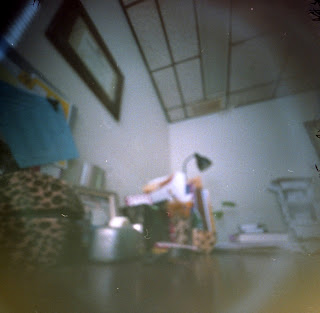 well, maybe the oatmeal container isn't that small or necessarily good, but i'm hoping the pinhole will be. and certainly the shutter is sweet!
well, maybe the oatmeal container isn't that small or necessarily good, but i'm hoping the pinhole will be. and certainly the shutter is sweet!i decided my new year's resolution will be to experiment with paper negatives. using this most excellent resource (see esp. the shutter page) i built the camera last week and am now deciding what paper and developer i'd like to try.
in the meantime. . .
having been able to achieve with the pinhawk something of the sharpness i was hoping to achieve when i started experimenting with pinhole cameras, i decided to try the zero image again to see if using a more stable tripod, shooting indoors and ensuring the camera didn't move at all would help combat some of the softness i found with the zero image test roll. all i can say is thank goodness there weren't any non-reproducible images on the second roll. (well, technically there were a few that would be hard to restage--images i had hoped to include in an upcoming process presentation but it wasn't necessarily an integral part of the presentation. . .). only two of the images (see the first two shots below) came out. most of the negative strip was clear. i could see a shadows of images here and there and on a few of the frames i could make out something at the sides/top and bottom of each frame but for the most part, the negatives were a mess. unusable. as a matter of fact, i've never (not even when working with diana or holga) have i had this many unusable frames per roll.
so if the bear and photo shots below had looked like the others, i might have reasoned that the developer time was wrong or that something went wrong inside the camera. i have no idea at this point how to make sense of what exactly happened, why or how to ensure it doesn't happen again. it could simply be a matter of miscalculating the exposure time but i used the same process as i did with the first roll.
but here's another mystery about the zero one. after i saw the negatives, i decided to see if something was blocking the pinhole. (again, that the last two images were the only two to look halfway "normal" makes me think that whatever happened had worked itself out by the end of the roll.) compared with the pinholes i've made, this one seems. . .i don't know, fuzzy? with the ones i've made if i hold them up to the light, the light comes sharply though the pinhole. not in this case. i'm not sure if that's a feature of zero one pinholes or if mine is shall we say, "unique."
though i hadn't planned to use the zero image over the holidays, i really needed to see what would happen if i shot another roll of film in the camera. if the problem was the pinhole, it made sense that my exposure times would be wildly off.
luckily, i had an expired roll of efke kb 400--this would allow for shorter exposure times and the fact that there were 24 exposures on the roll meant that i could shoot and develop a roll rather quickly. i calculated the exposure times as i had with the other two rolls and these were all fine--all there (see images beneath first two below). a bit over-exposed but i knew i had gone a bit long on some of the shots, hoping for more light-play/contrast then a normal exposure would afford. so yeah. not sure what happened with the other roll. and i'm still not certain if there's something up with the pinhole.
i kept the camera steady for most of the shots but they are not nearly as sharp as the last pinhawk images. i understand that part of this has to do with the distance between the pinhole and film. and it's not that i'm not liking the zero image images, it's more a matter of being frustrated again by the lack of sharpness.




















































